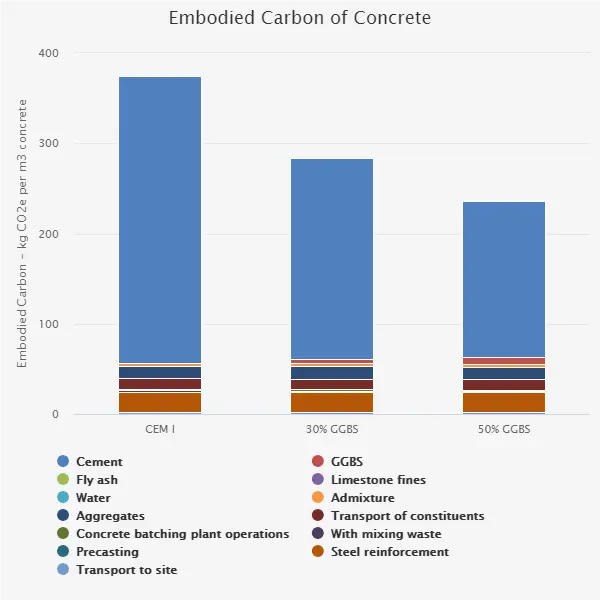Concrete Embodied Carbon Footprint Calculator
Concrete is one of the main contributors to the embodied carbon footprint of most buildings and infrastructure assets. It also offers one of the top quick win embodied carbon reduction measures. The specification of greener concrete mixtures has great potential to reduce the carbon footprint of construction.
Materials such as ground granulated blast furnace slag (ggbs) and pulverised fuel ash (pfa), have cementitious properties and can be used in a concrete mixture to reduce the amount of cement. Ordinary Portland Cement, or OPC as it is also known, has a higher embodied carbon than ggbs or pfa. The material pfa is also known as just fly ash.
Embodied Carbon Database
Circular Ecology has created an embodied carbon calculator for concrete, as part of the free embodied carbon database for materials known as the ICE database. The ICE database was originally created as a research project at the University of Bath by Dr Craig Jones, Circular Ecology, and Professor Geoffrey Hammond.
The latest version of the ICE database, V3, was updated by Circular Ecology and was co-funded by Heathrow Airport, the Rail Safety and Standards Board and the Environment Agency.
There is an excel version of the carbon calculator available with every download of the ICE database.
Embodied Carbon Calculator for Concrete
There is also an online version of the calculator available on this page.
The below calculator will model the embodied carbon of up to three concrete mixtures.
An example of the embodied carbon results is shown below:

To see the full emissions factors, assumptions and calculations, download a copy of the ICE database. The excel version of the concrete embodied carbon calculator is included in the freely available ICE database download file.
Using the Concrete Embodied Carbon Calculator
Simply enter details of the concrete mixture, in terms of the material constituents per m3, click calculate, then download the optional pdf report.
If you are working on a specific building, it may help to have the concrete design certificate from your concrete supplier. This will tell you exactly what is in your concrete per m3, in terms of cement, CEM I, ggbs, pfa, aggregates, additives…etc. Using the actual concrete mixture increases accuracy of embodied carbon assessments considerably.
View an example of the pdf output, embodied carbon concrete report.
The boundaries of this calculator is cradle to site. It can also model cradle to gate, if you set the transport distance to site as zero.
The concrete embodied carbon calculator is below:
To reset the calculator, just refresh the page.
Cement replacement materials, such as GGBS and fly ash, can be selected by:
- Selecting a cement type with the correct blend in section 1b; and by
- Adding additional cement replacement material in section 1c.
Do NOT double count the cement replacement materials
Ready-mix / in--situ=11 km
Precast=95 km
Source: Mineral Products Association (MPA)
These are the terms of use for the Inventory of Carbon & Energy (ICE) database, which must be abided by:
- The ICE database must not be distributed nor uploaded to websites without the written permission of the authors. Instead the link to the download website should be referred to, which will always contain the most recent version of the database, https://www.circularecology.com/embodied-carbon-footprint-database.html
- The data contained within the ICE database may be used on projects and within carbon tools - so long as full reference to the database is provided and with a link to the download website to ensure readers can check for the most recent version of the ICE database
- The ICE database shall not be reproduced, copied, distributed, published, modified or in any way exploited, in whole or in part
- The disclaimer below shall be adhered to
Whilst efforts have been made to ensure the accuracy of the information contained in the Inventory of Carbon & Energy (ICE), the content is subject to change and the authors and their affiliated organisations cannot guarantee its accuracy or currency. The right is reserved to make changes to the information without notice.
The information is consequently provided "as is" without any representation or warranty as to accuracy, currency, quality or fitness for purpose of any kind. You should independently verify any information contained in ICE before relying on it.
The authors and their affiliated organisations do not make any representation nor give any warranty as to the ownership of the copyright of any material forming part of ICE and does not accept any liability for any direct, indirect, incidental or consequential losses arising from the infringement of any third party rights in relation to any material in ICE.
Further Information
If you are interesting in finding out more about this embodied carbon tool for concrete, please download a copy of the excel version.
The excel version contains the full emissions factors, assumptions and calculations. It is available with the ICE database download, which is a free embodied carbon database for materials.
Comments
Enter your comment below to share your thoughts.
